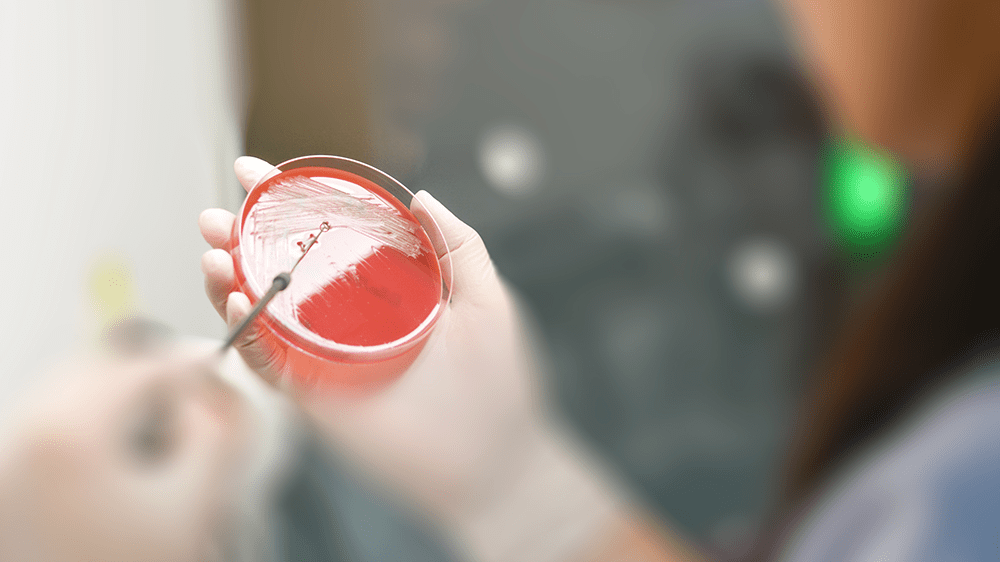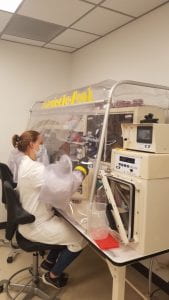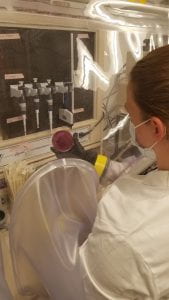by Elise Wachspress
For those who remember the 1970’s, “streaking” might mean “running through public places naked.”
But if you’ve ever taken a microbiology class, you know one of the first lab lessons is “streaking a plate,” a technique used to spread a sample of bacteria out across a petri dish filled with agar, a Jello-like substance from seaweed also used in ice cream and some candies. Streaking is used to separate the bacteria and get them to grow in individual “colonies,” which can, perhaps with further streaking, be purified into samples of one single type of bacteria.
First perfected well over a century ago in the lab of Robert Koch, streaking samples from people infected with TB, anthrax, and cholera helped researchers make major inroads in understanding (and thus fighting) these diseases.
But the technique’s limits soon become obvious. Microbes, by far the earth’s oldest life form, have evolved to live in all sorts of conditions uninhabitable by other creatures: arctic ice, volcanoes, acidic sulfur springs, even under enormous pressure at the bottom of the sea. Expecting bacteria acclimated for life in these extreme environments to survive, much less grow, on a simple plate of agar on a shelf in a lab is not going to work.
Even some bacteria that inhabit the human body are resistant to this method. Many gut bacteria die or fail to thrive in environments with oxygen. Claire Kohout and her DFI biobank team are experts at growing, purifying, characterizing, and storing these “anaerobes.”
They grow the bacteria within oxygen-free plastic bubbles that contain only nitrogen, carbon dioxide, and hydrogen; a palladium catalyst assures that any tiny bit of remaining oxygen reacts with the hydrogen and drops out of the atmosphere as water. The six- to eight-feet-long anaerobic chambers are fitted with air locks and rubber gloves to allow the scientists to work with the samples inside.
Inside, the bacteria may sometimes grow on agar plates supplemented with essential nutrients or often in a liquid broth. In both cases, the growth media must be in the anaerobic environment for at least 24 hours to ensure all traces of oxygen are gone; for particularly sensitive anaerobes, they sometimes use a special dye to indicate oxygen contamination. They purify and carefully characterize the bacteria within this oxygen-free environment and then transfer them to special tubes to be frozen and safely stored at -80° C for future research.
Eric Pamer, MD, director of the Duchossois Family Institute (DFI), started the collection several years ago when he was working at Memorial Sloan Kettering Cancer Center in New York. Now, with DFI institutional support, it will grow substantially. Since the fledgling biobank was moved to Chicago, Kohout and company worked first to establish and communicate protocols among both those collecting samples and those who will be using them. Now, as the labs move forward carefully after COVID temporarily shut down the labs, the focus is on growing the collection to support the Institute’s rapidly expanding research portfolio.
Most samples are from healthy human donors, the idea being that these can help researchers better understand how our internal bacterial communities support human well-being. Interestingly, researchers have found that, although microbial populations differ significantly from one healthy person to another, they generally have one thing in common: internal diversity. Like other ecosystems and societies, gut communities benefit from variety; samples from people who are ill tend to have fewer types of bacteria living within them.
So far, most of the samples come from routine colonoscopies. (So besides your primary reward for the undertaking that uncomfortable prep—hearing that you do not have colon cancer and you needn’t repeat the procedure for ten years—a secondary bonus is knowing you can help to advance science and medicine.) While the DFI biobank currently concentrates on gut samples—the largest conglomeration of bacteria in the body—Kohout anticipates they will eventually expand to samples from oral and skin communities.
The biobank, Kohout says, is “at the center of all the Institute’s platforms,” providing the samples for most of the research undertaken in the DFI. Under Pamer’s aggressively collaborative leadership, the DFI will even provide special samples to other research institutions which share the DFI’s central mission: to maximize good health and the economic, social, and personal benefits it delivers.
Elise Wachspress is a senior communications strategist for the University of Chicago Medicine & Biological Sciences Development office






